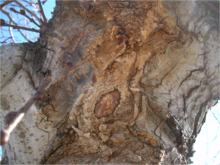Slime flux, also known as bacterial slime or bacterial wetwood, is a bacterial disease of certain trees, primarily elm, cottonwood, poplar, boxelder, ash, aspen, fruitless mulberry and oak. A wound to the bark, caused by pruning, insects, poor branch angles or natural cracks and splits, causes sap to ooze from the wound. Bacteria may infect this sap causing it to darken and stain the bark, eventually taking on a foamy appearance and unpleasant odor. This slimy ooze becomes toxic to the bark and eats into the tree. The fermented sap attracts insects like flies, ants, and maggots.
| Slime flux | |
|---|---|
 Slime flux on a Camperdown Elm caused by Pectobacterium carotovorum. Note the ooze (dark ring in the center) and the discoloration of the bark. | |
| Causal agents | Bacteria (Brevundimonas bullata, Paracoccus alcaliphilus, P. marcusii and Luteimonas aestuarii, and Pectobacterium carotovorum) |
| Hosts | Trees (elm, cottonwood, poplar, boxelder, ash, aspen, fruitless mulberry and oak) |
| EPPO Code | ERWICA |
Cause
editSlime flux occurs when a wound is made in a tree trunk through things such as natural growth cracks, frost, insects, birds, lawn mowers, cat scratches, or pruning wounds, which causal bacteria can enter. Once inside the xylem, the internal pressure of the tree is raised, from the normal range of 5 to 10 psi (0.3 to 0.7 bar) up to 60 psi (4 bar), due to bacteria fermenting and emitting a gas mixture of methane, nitrogen, carbon dioxide, and oxygen. This accumulation of liquid and gas causes that part of the tree to have a damp, dark brown appearance known as wetwood.[1] Eventually, the pressure will cause the sap and gasses to burst through the xylem and out of cracks in the trunk and ooze down the side of the tree. This sap flux may be further infected by other pathogens once exposed to the air such as air-borne bacteria, yeast, and other fungi, at which point it is known as slime flux.[2]
Causal agents
editCausal bacteria for the initial wetwood varies depending on the species of tree. The bacteria are commonly found in water and soils.[1] Enterobacter spp., Bacillus spp., Pseudomonas spp.[3] Xanthomonas spp., Agrobacterium spp., Acinetobacter spp., Corynebacterium spp., Bacteroides spp., Clostridium spp., Edwardsiella spp., Klebsiella spp., Lactobacillus spp., Methanobacterium spp.,[4] Brevundimonas bullata, Paracoccus spp. and Luteimonas aestuarii have been isolated from wetwood in various tree species.[5]
Species of Prototheca have been isolated from slime fluxes.[6]
Potentially affected plants
editReferences
edit- ^ a b Jacobi, William R.; Ball, John (2016). "Wetwood (Slime Flux) and Alcohol Flux in Hardwoods". Diseases of Trees in the Great Plains. USDA Forest Service. pp. 120–123.
- ^ Hamilton, Douglas W. (September 1980). "WETWOOD AND SLIME FLUX IN LANDSCAPE TREES". Journal of Arboriculture. 6 (9): 247–249.
- ^ Murdoch, C. W.; Campana, R. J. (April 1983). "Bacterial Species Associated with Wetwood of Elm". Phytopathology. 73 (9): 1270–1273. doi:10.1094/Phyto-73-1270.
- ^ Schink, Bernhard; Ward, James C.; Zeikus, J. G. (1981). "Microbiology of Wetwood: Role of Anaerobic Bacterial Populations in Living Trees". Microbiology. 123 (2): 313–322. doi:10.1099/00221287-123-2-313. ISSN 1350-0872.
- ^ Alizadeh, M.; Khakvar, R.; Babai-Ahari, A. (2017-12-01). "Isolation and characterization of bacterial agents associated of wetwood disease on elm trees in Iran". Acta Phytopathologica et Entomologica Hungarica. 52 (2): 157–168. doi:10.1556/038.52.2017.028. ISSN 1588-2691.
- ^ Pore, R. S. (1986-05-01). "The association of Prototheca spp. with slime flux in Ulmus amencana and other trees". Mycopathologia. 94 (2): 67–73. doi:10.1007/BF00437369. ISSN 1573-0832. S2CID 27391222.
- ^ a b c d e f g "IPM : Reports on Plant Diseases : Bacterial Wetwood and Slime Flux of Landscape Trees". ipm.illinois.edu. September 1999. Retrieved 2021-03-16.
- ^ a b c "Cordyline slime flux". rhs.org.uk. Royal Horticultural Society. Retrieved 2021-03-15.
- ^ a b c d e f g h i j k l m n "Wetwood". The Morton Arboretum. Retrieved 2021-03-15.
- ^ a b c d e f g h i j k l m n o Sanogo, Carmen (23 April 1999). "Bacterial Wetwood (Slime Flux) in Trees". hortnews.extension.iastate.edu. Retrieved 2021-03-15.
- ^ Pecknold, Paul C. (January 2016). "Slime Flux". Purdue e-Pubs. Retrieved 2021-03-16.
- ^ a b "Slime Flux". extension.usu.edu. Retrieved 2021-03-15.
- ^ Olsen, Mary W.; Young, Deborah J. (September 1998). "Slime Flux or Wetwood" (PDF). The University of Arizona Cooperative Extension. Retrieved 2021-03-16.
- ^ a b "Slime Flux of Trees". Purdue Extension Forestry & Natural Resources. 2020-07-10. Retrieved 2021-03-16.
- ^ Heimann, Mary Francis; Hudelson, Brian (19 May 2009). "Bacterial Wetwood | Plant Disease Diagnostics Clinic". pddc.wisc.edu. Retrieved 2021-03-15.
- ^ "Clematis slime flux". rhs.org.uk. Royal Horticultural Society. Retrieved 2021-03-15.
- ^ Ogilvie, Lawrence (1924-03-31). "Observations on the "slime-fluxes" of trees". Transactions of the British Mycological Society. 9 (3): 167–182. doi:10.1016/S0007-1536(24)80019-0. ISSN 0007-1536.
- ^ Ogilvie, Lawrence (May 10, 1924). "Research Items". Nature. 113 (2845): 691–693. Bibcode:1924Natur.113..691.. doi:10.1038/113691a0.
- ^ a b c "Bacterial Wetwood (Slime Flux)". www.agr.gc.ca. Government of Canada. 2014-06-10. Retrieved 2021-03-15.
- ^ Zhou, Jianghong; Xia, Fei; Che, Shaochen; Wang, Jianhong; Zhang, Guofeng (2020). "Providencia rettgeri as the causal agent of the brown slime flux of Populus tomentosa". Forest Pathology. 50 (1): e12576. doi:10.1111/efp.12576. ISSN 1439-0329. S2CID 213932836.
- ^ Vann, Stephen. "Wetwood of Shade Trees" (PDF). uaex.uada.edu. Retrieved 2021-03-16.
- ^ Jacobi, W. R. (December 2013). "Bacterial Wetwood" (PDF). Colorado State University Extension. Retrieved 2021-03-16.
- ^ Carter, J. Cederic (August 1945). "Wetwood of Elms" (PDF). IDEALS @ Illinois. Retrieved 2021-03-16.
- ^ Goldberg, Natalie P. (October 2006). "Slime Flux" (PDF). New Mexico State University. Retrieved 2021-03-16.
- ^ Mohan, S. Krishna; Colt, Wm. Michael; Barney, Danny L. (November 1990). "Bacterial Wetwood and Slime Flux of Trees". University of Idaho Digital Collections. Retrieved 2021-03-16.
- Alizadeh, M.; Khakvar, R.; Babai-Ahari, A. (2017). "Isolation and characterization of bacterial agents associated of wetwood disease on elm trees in Iran" (PDF). Acta Phytopathologica et Entomologica Hungarica. 52 (2): 157–168. doi:10.1556/038.52.2017.028.
- slime flux on www.forestpests.org
- [1]